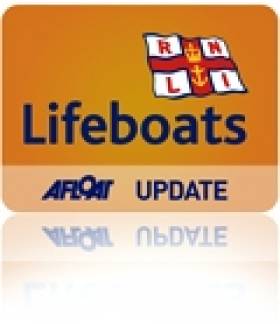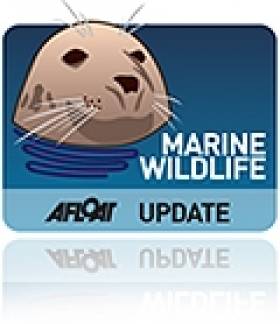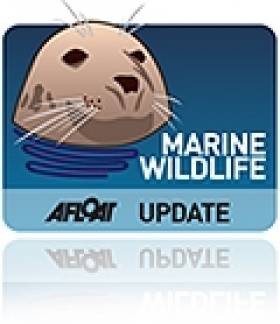Displaying items by tag: Baltimore
Open Day At Baltimore Lifeboat Station This Weekend
#RNLI - The crew of Baltimore Lifeboat Station are inviting the public to an open day on Sunday 29 September from 2.30pm to 5.30pm.
Visitors on the day will have an opportunity to see the redeveloped station house at Bullpoint and the co-located lifeboats operating from there.
The inshore lifeboat Atlantic 75 RIB Alice and Charles is housed inside the station house on a carriage and the Tamar class all-weather lifeboat Alan Massey lies alongside in a newly excavated berth.
Crew will be on hand to show people around the station house and the lifeboats as well as giving a first hand account of rescues at sea. Information on RNLI Sea Safety resources will also be made available.
All are welcome to the open day, which is free of charge.
Baltimore RNLI Inshore Lifeboat Bring Home Four People (& 2 Dogs!)
#rnli – The Baltimore RNLI inshore lifeboat went to the assistance of a motor cruiser whose engine failed near Horse Island in West Cork this afternoon Tuesday 20th August. The alarm was raised at 15:05 and within minutes the lifeboat was underway. Helm John Kearney and his crew proceeded through the islands of Roaring Water Bay to rendezvous with the stricken vessel which had subsequently anchored between Horse Island and Castle Island.The 6.5m day cruiser whose engine had overheated had a party of 2 men, 2 women and 2 dogs on board at the time and had been on passage from Baltimore to Schull. The lifeboat crew passed a tow to the vessel and took her in tow returning her to her moorings in Baltimore Harbour.
Helm John Kearney commended them for staying calm, he said 'They did everything right, they were wearing life jackets and anchored promptly to secure their safety when her engines failed'.
Helm John Kearney, crew Ger O"Brien and Peter Losberg. Slip crew John O'Flynn, Colin Rochford and Declan Tiernan.
Baltimore RNLI Launches From New Station To Two Flare Sightings
#RNLI - Two red flare sighting in recent days prompted launches by the Baltimore RNLI volunteer lifeboat crew - the first from the new station at Bullpoint.
On Saturday last (27 July) a red flare was reported after 8pm in the area of Inisbeg on the Ilen River, near Skibbereen in West Cork.
Helm Micheal Cottrell and his crew carried out a search as far upriver as the rowing club, making inquiries with vessels on the river. With no trouble found, the search was stood down and the lifeboat returned to the station at 9.10pm.
Then on Tuesday night (30 July) the alarm was raised when a member of the public reported sighting a red flare to the southwest of Tragumna Beach just before 11pm.
The all-weather lifeboat proceeded to Tragumna Bay, where a local fishing boat had already begun a search. Coxswain Kieran Cotter spoke by mobile phone with the observer of the flare, and the lifeboat searched west along the shoreline towards Tragumna Beach in response to the observer's directions.
By midnight nothing had been found, and the search was stood down as all indications were that this was most likely a firework or chinese lantern launched from the headland southwest of Tragumna.
Baltimore RNLI lifeboat operations manager Tom Bushe commented that he was "delighted with how the new carriage launching system worked" and thanked the volunteer crew and shore crew for all their hard work in learning new procedures.
Furthermore he advised that if people are setting off fireworks or releasing chinese lanterns in coastal areas to notify the coastguard of their intent.
Volunteer crew on board the inshore lifeboat were helm Micheal Cottrell, Tadhg Collins and Connor Dempsey, with shore crew comprising Jerry Smith, Rianne Smith and Seamus O'Driscoll. Volunteer RNLI crew on board the all-weather lifeboat were coxswain Kieran Cotter, mechanic Cathal Cottrell, Jerry Smith, Sean McCarthy, Tadhg Collins, Shane McSweeeny and Eoin Ryan.
Baltimore RNLI Lifeboat Tows Yacht & Two Sailors to Safety
#rnli – Baltimore RNLI lifeboat was called today at 6:36pm Friday 26 July to assist a yacht in difficulty west of the Stags Rocks near Baltimore Harbour in West Cork. The 30ft yacht had 2 people on board, a man and a woman, when their engine failed and they were unable to sail into Baltimore against a strong tide. The Tamar class all weather lifeboat Alan Massey, located the vessel and took her in tow to the safety of Baltimore Harbour.
Baltimore RNLI Coxswain Kieran Cotter commented that 'while the yacht was in no immediate danger, it was prudent to seek assistance during daylight hours before the situation could escalate'.
Volunteer RNLI crew on board were Coxswain Kieran Cotter, Mechanic Brian McSweeney, Micheal Cottrell, Cathal Cottrell, Brendan Cottrell, Don O'Donovan and Diarmuid Collins.
Recession Hit Glenans Warns of 'Possible Closure' of Collanmore & Baltimore Sail Training Bases
#glenans – A 'financially struggling' Les Glenans association is considering closing the doors on its operation in Ireland, according to president Michael O'Meara who signalled the potential move to members in a letter last Friday. No decision has been made yet, but it looks likely at least one of two Irish bases will close at the end of the year.
The popular sail training club has been one of the largest such organisations in the country over the past 44 years, training up to an estimated 40,000 in that period, O'Meara told Afloat.ie.
The association currently has 1,500 members in Ireland and was reintegrated with its French counterparts in November 2010, a move Les Glenans said at the time would underpin its future.
Its 2013 season brochure was launched with some fanfare in April by Leo Varadkar TD, Minister for Transport, Tourism and Sport in Dun Laoghaire, but a lack of demand for courses since has caused it to review its Irish operation. It is looking at closing bases in Collanmore, County Mayo and Baltimore in West Cork.
'There are a number of reasons for this, including (but not exclusively) the repayment of GISC [Glenans Irish Sailing Club] debt and the current economic situation in Ireland as well as in France', O'Meara said in his letter last Friday.
Though the total numbers of trainees increased in the immediate year after reintegration this initial increase was in French trainees not in Irish ones, and this has not been sustained.
Despite large investment, the 'Secteur' has continued to make a loss, O'Meara said:
Some of the reasons cited for the decline include:
· Economic crisis in Ireland and across the EU
· Very poor summer weather since 2009 - people preferring to travel abroad. This has added to the continued decline in adult dinghy and catamaran sailing.
· Prohibition on paid advertising and marketing since the integration
· Website and translation issues
The total Glénans association has also experienced poor financial performance in recent years. 2010 was the last year in which the association made a positive result.
Unfortunately,a large fraction of this cost and loss is pertaining to the Irish Secteur. The poor performance and financial results are not sustainable and if not significantly improved (i.e. increase in trainees and course sales) will jeopardise the future of the overall organisation.
As a result, there are a number of solutions presently being discussed by management and the board of directors. Whilst no decisions have yet been made, it is likely that one of the Irish bases (Collanmore) will close permanently at the end of the 2013 season.
There is also the possibility that without a swift major upturn in Irish activity Baltimore will also close at the end of the current season - thus ending the Glénans activity and presence in Ireland.
There are a number of external factors to be taken into account before any further discussion by the Les Glénans board (Conseil) can take place and before any decision can be made.
Meanwhile, the Secteur Committee has formed a working group to explore all solutions to the situation and to formulate a proposal to the board in order to ensure the continuation of operations in Ireland.
O'Meara has urged members to give their 'continued support' for the association. 'Booking in for courses and raising the profile by word of mouth and other means will increase our activity level, provide tangible support to our proposal and may have an influence in the decision making process'.
In 2009, the Irish club raised in excess of €80,000 from members and supporters. The fundraising, undertaken to help secure the clubs future, and allowed Glenans to upgrade its fleet and continue to offer high quality RYA and ISA approved sail training at its bases in Baltimore in west Cork and Collanmore in Clew Bay.
But in November 2010, members of Ireland's biggest sail training organisation, Glenans Irish Sailing Club voted unanimously to reintegrate with the French-based sailing association Les Glenans as a means of stemming losses.
The decision was designed to allow the Glenans sailing school activity to continue in Ireland at both bases in Collanmore and Baltimore, and it secured the financial future of the Irish organisation which has experienced an increasingly difficult trading environment
It was thought at the time the reintegration would reunite the two associations which share the common aim of bringing people together through a love of sailing and the sea. The idea was to give the Irish members access to Les Glenans' Europe wide sailing activities and allow Les Glenans to offer a unique Irish sailing experience to its 14,000 members.
Under the 2010 agreement Les Glenans took over the assets and liabilities of Glenans Irish Sailing Club. The Club's two Irish sail training bases at Baltimore, County Cork and at Collanmore Island, in Clew Bay, County Mayo continued to operate .
The Irish bases become part of Les Glenans network of sailing bases across France and Italy. Ireland formed one of Les Glenans five administrative sectors, with Irish members having full voting rights in the enlarged association.
RNLI Lifeboats Have Busy June Bank Holiday Weekend
#RNLI - It was a busy June bank holiday weekend around the country for RNLI lifeboats in West Cork, Mayo and the Midlands.
On Sunday afternoon, Baltimore RNLI assisted four people after their yacht got into difficulty a mile south of Mizen Head.
The 32ft yacht with four people on board had been propped by a pot buoy immobilising her in the water. The alarm was raised at 10.41am and lifeboat the Alan Massey was launched minutes later.
A local RIB, which had commenced towing, passed the tow to the lifeboat and the yacht was then taken to the safety of Crookhaven Pier.
This was the second call out this week for Baltimore RNLI. On Thursday last three men were rescued when their punt overturned near Horse Island.
Later on Sunday, Achill Island RNLI in Co Mayo brought a distressed fishing vessel with seven people on board to safety.
The volunteer lifeboat crew was requested to launch at 4.50pm to assist a small fishing vessel in the vicinity of Clew Bay and close to Clare Island. The vessel had encountered engine problems and was unable to return to port.
The boat and its crew of seven were subsequently towed safely to Curraun harbour by the Achill Island RNLI lifeboat.
Speaking after, Achill Island RNLI lifeboat operations manager Tom Honeyman said: "The presence of thick fog surrounding the vessel meant that great care was needed in the rescue and the fishing party of the vessel were delighted to return empty handed for a change."
Meanwhile in the Midlands, Lough Ree RNLI brought five people to safety in two call-outs over the weekend.
On Friday 31 May the volunteer crew was requested to launch around 5pm following a report that a cruiser had ran aground north of Quaker Island.
A local fisherman raised the alarm after spotting the cruiser on the rocks at the island located in the north end of Lough Ree raised the alarm.
The lifeboat crew managed to establish contact with the person on board the cruiser via mobile phone and he had confirmed that he had got lost and had ran aground. He reported that there was no water entering his boat. He was on his own but not injured.
The inshore lifeboat was launched and the crew was on scene at 5.30pm. It took the lifeboat 10 minutes to safely navigate its way through the rocky area to reach the casualty. The person on board the cruiser was taken to shore and arrangements were made for a specialist company to attend the scene to recover the cruiser.
Lough Ree RNLI was then launched on Sunday evening to assist a 26ft cruiser which had ran aground east of Green Island after sustaining engine failure.
The small cruiser with a family of four on board had lost engine power and had ran aground on the south east side of Lough Ree.
A crew launched the lifeboat at 8.40pm and arrived on scene 10 minutes later. After one of the lifeboat crew had carried out an assessment of the causality vessel, the decision was made to make an attempt to pull the vessel from the rocks, which the lifeboat was successfully able to complete.
Once the lifeboat had the vessel in deep water, a tow was set up and the casualty vessel was taken to Quigleys Marina in Athlone.
It marked the continuation of a dramatic week for the Lough Ree crew, after six were rescued from a sinking cruiser on the lough last Tuesday 28 May.
Both Baltimore RNLI lifeboats responded to an emergency in the Ballydehob area last evening. The alarm was raised at 17.45 and both the all-weather and inshore Lifeboats responded immediately.
A kayaker had reported persons in the water between Horse Island and Audley cove.
The ILB helmed by Michael Cottrell was first on the scene and was directed by the kayaker towards persons in the water. Assisted by crew Gerald O Brien and Pat O Driscoll two casualties were recovered from the water.
One was a good swimmer and was keeping his friend's head above water, both desperately hanging on and near exhaustion. Pat O Driscoll entered the water to help keep the distressed casualty afloat and both were recovered to the ILB.
The ALB and Schull Lifeboat arrived on scene minutes later and both casualties were transferred to Baltimore lifeboat for first aid. The ALB made best speed to Schull Harbour where medical resources had been requested to attend.
Goleen Coastguard were at the pier to assist with landing the casualty and doctor and ambulance arrived soon after.
A 3rd survivor who had been rescued and brought to safety by the kayaker was transferred from Audley Cove by the ILB to join his friends in Schull.
Concern centered around the condition of the most distressed casualty. He was hypothermic and had swallowed a considerable amount of seawater.
The Coastguard rescue helicopter from Shannon arrived on scene, landed in adjacent playing fields and airlifted him to hospital.
None of the survivors were wearing life-jackets and all were lightly clad. Their small craft had capsized and they were attempting to swim to shore.
The evening was fine and warm but with a stiff Northerly breeze. A strong flood tide was sweeping through the sound between Horse Island and the shore.
Baltimore Lifeboat was crewed by Coxswain, Kieran Cotter, Mechanic, Sean McCarthy along with Jim Griffiths, Ger Sheehy, Ronnie Carthy, John O Flynn and Eoin Ryan
A temporary floating pontoon for visiting boats is present during the summer season that makes it easier for boaters to enjoy this extensive harbour with good anchorage. The pontoon is suitable for up to seven or eight boats and is used by a mix of cruising boats, ribs and local fishing boats.
Humpback Surprises West Cork Over St Patrick's Weekend
#MarineWildlife - A juvenile humpback whale sighting off West Cork provided a St Patrick's weekend surprise for cetacean watchers.
Irish Whale and Dolphin Group (IWDG) sightings co-ordinator Pádraig Whooley writes on the discovery made off the Stags on the afternoon of Monday 18 March, which was verified by IWDG members Simon Duggan, Youen Yacob and Robbie Murphy.
Photo ID images captured at the scene allowed experts to confirm the whale is a newcomer to Irish waters, bringing the known total to 22 and continuing a growing trend.
Whooley also notes the unusual nature of the sighting, coming some months after the busy humpback whale activity in the area previously reported on Afloat.ie.
Those whales weren't seen again after that flurry of breaching and bubble-netting off Baltimore - presumably because being an older group, they were drawn south by their migratory instinct to the tropical feeding grounds.
In contrast, this likely juvenile - named Baltimore - may have opted to winter in higher latitudes to avoid competition with bigger counterparts, something that a group of humpbacks in the Norwegian fjords have also chosen to do this year.
The IWDG has more on the story HERE.
Video: Courting Humpback Whales Duel Off Baltimore
#MarineWildlife - Check out this wonderful video - via the Baltimore Photos Facebook page - of two male humpback whales fighting over a prospective female partner off West Cork late last year.
Richard O'Flynn, who posted the footage to YouTube, says: "We were following two humpbacks for about 30 minutes when a third one turned up.
"What you're seeing here is the female to the right of the shot and her partner between her and the third humpback trying to keep him away from her. It went on for about one-and-a-half hours!"
O'Flynn said it was only his second time using the video camera "so please forgive the shake... and I was driving the boat at the same time!"

































































